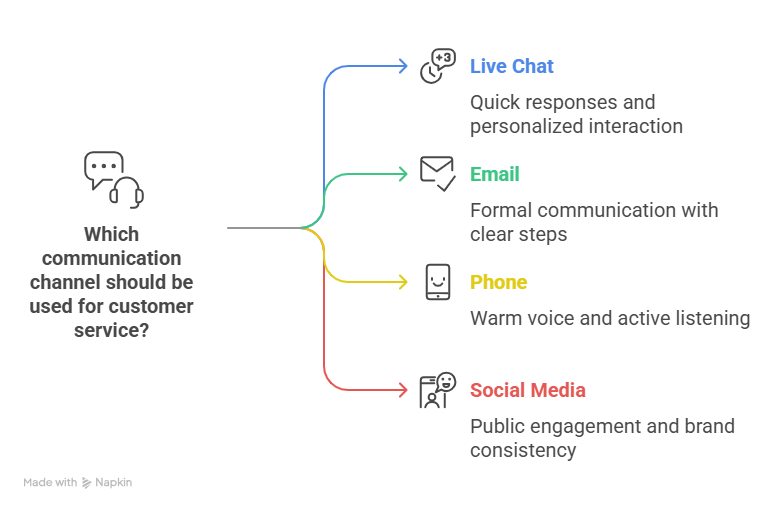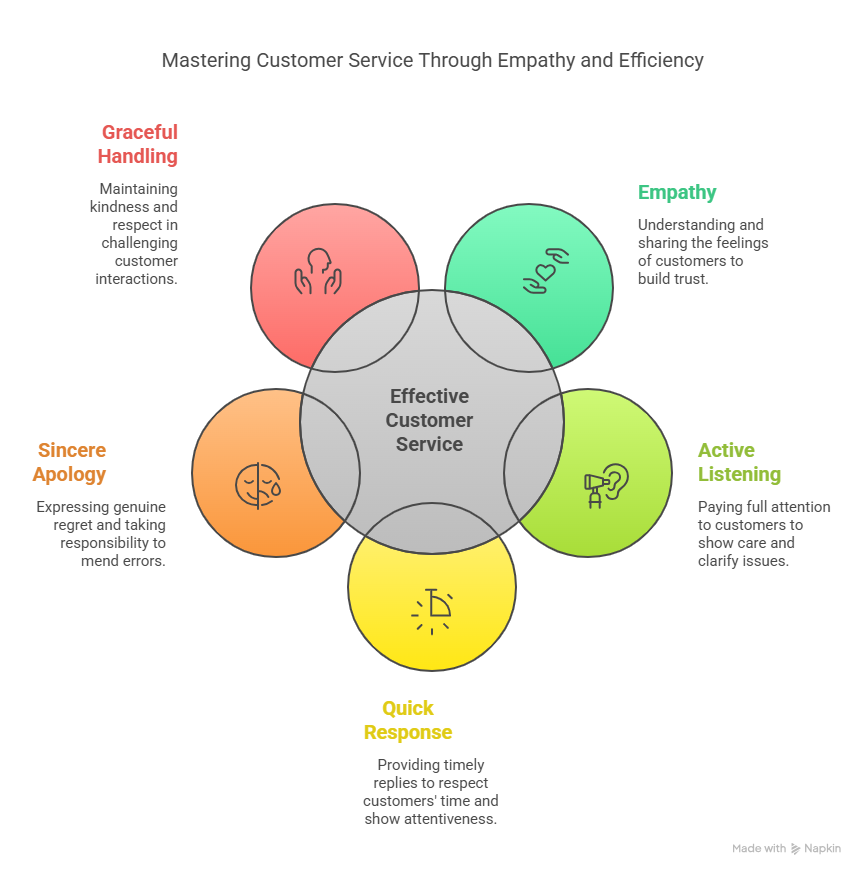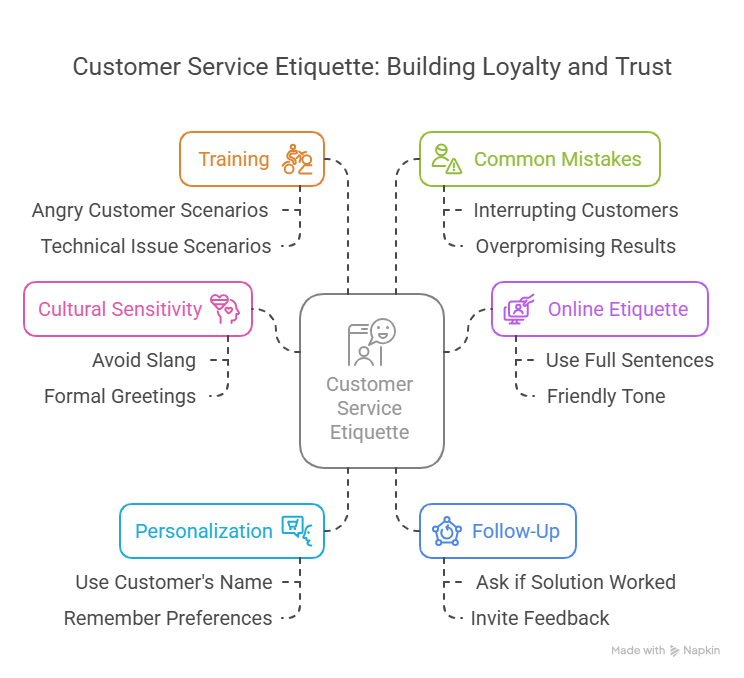
In today’s world, customers expect more. One bad moment can cost more than a sale, it can lose a customer for life. The key difference often lies in customer service etiquette. It’s more than being polite. It means speaking clearly, showing care, and staying professional in every interaction. This guide covers the key rules, best habits, and mistakes to avoid in great customer service.
What Is Customer Service Etiquette?
Etiquette means the right way to act and speak with customers. It includes:
- Using a respectful tone
- Listening carefully
- Responding fast
- Showing empathy
- Solving problems calmly
No matter the channel, email, chat, phone, or social media, good etiquette shapes how people see your brand.
The Basics of Great Customer Service Etiquette
1. Always Be Polite
Politeness builds trust and calms upset customers. Use phrases like:
- “Thanks for your patience.”
- “I get how frustrating this is.”
- “Can I help you with anything else?”
Simple manners can make a big difference.
2. Speak Simply and Clearly
Skip jargon and technical terms. Make sure anyone can understand you.
Use: “Please restart your device and try again.”
Avoid: “Initiate a power cycle and verify system operability post-reboot.”
Communication Best Practices in Different Customer Service Channels

Live Chat
- Reply fast within 30 seconds.
- Use the customer’s name.
- Write with good grammar. Skip slang.
- Confirm you got the message quickly.
- Give clear next steps or a timeline.
- Keep the tone friendly and formal.
Phone
- Smile, it makes your voice sound warm.
- Let them talk. Don’t cut them off.
- Repeat key points before ending.
Social Media
- Stay calm, even if they complain in public.
- Reply in public, then move it to private.
- Use emojis only if they fit your brand.
The Role of Empathy in Customer Service Etiquette

Empathy Builds Trust
Empathy means feeling what the customer feels. It’s key to great service.
How to show empathy:
- Say: “I understand,” “That sounds tough,” or “Let me help.”
- Avoid canned replies. Speak like a real person.
- Stay patient with upset or confused customers.
Listen Actively
Active listening proves you care and want to help.
Tips to listen well:
- Don’t interrupt.
- Repeat back what you hear: “So you’re saying…”
- Ask: “Can you tell me more about that?”
This clears up confusion and shows their voice matters.
Respond Fast
Quick replies show you respect their time. Delays feel rude and careless.
Quick Replies Matter
- Live chat: Answer in 30 seconds or less
- Email: Get back within 24 hours
- Phone: Pick up by the third ring
- Social: Try to reply in an hour
If it’ll take longer, let them know. Keep them in the loop.
Saying Sorry Shows You Care
When things go wrong, a sincere “I’m sorry” means a lot. It shows you’re human and you care.
How to apologize well:
- Acknowledge: “I’m really sorry this happened.”
- Take the blame: “We fell short here.”
- Fix it: “Let’s make this right, here’s what I can do.”
Skip excuses. People respect honesty.
Handle Tough Moments with Grace
Not every chat will be easy. Some folks will be upset or rude. Stay kind.
What to do:
- Breathe. Stay calm.
- Speak gently. Don’t raise your voice.
- Don’t take it to heart. it’s not about you.
- If needed, set kind limits: “I want to help, but let’s keep this respectful.”
Kindness, even in hard times, earns trust.
Cultural Sensitivity and Global Customer Service Etiquette

Respect Cultures in a Global World
In a global economy, your customers come from many backgrounds. What’s polite in one culture might be offensive in another. That’s why cultural awareness is so important in customer service. Respect builds trust and keeps conversations smooth.
Cultural Etiquette Tips:
- Avoid slang, idioms, or culture-specific jokes
- Use formal greetings unless told otherwise
- Be mindful of time zones when calling or emailing
Online Etiquette Rules
What you write online can stick around. A quick message might get screenshotted and shared, so every word matters. Stay professional and kind in all digital conversations.
Dos:
- Use full sentences and proper grammar
- Keep your tone friendly and calm
Don’ts:
- Avoid using ALL CAPS (it sounds like yelling)
- Skip extra punctuation (!!!???)
- Never reply when upset—cool off first
Make It Personal
Customers want to feel like people, not case numbers. A little effort goes a long way. Show that you see them and remember their past experiences.
Ways to personalize:
- Use their name
- Mention past issues or chats
- Remember their preferences when you can
Example:
“Hi Amanda, I saw you had a billing issue last month. I’ll make sure this goes smoother today.”
Follow-Up Shows You Care
Helping with a problem is great, but checking back in shows true care. A simple follow-up can turn a one-time fix into a long-term relationship.
Etiquette-Driven Follow-Up Includes:
- Asking if the solution worked
- Inviting honest feedback
- Providing your contact for future help
Train for Real-Life Scenarios
Good training includes practice. Role-playing helps teams stay calm and polite under pressure. It makes the theory real.
Useful scenarios to rehearse:
- Angry customer asking for a refund
- Frustrated user facing technical issues
- Language barriers or confusion
- Complaints about long wait times
Common Mistakes to Avoid
Even the best reps make mistakes. Knowing the common ones helps you avoid them and respond with more grace.
Mistakes and fixes:
- Interrupting the customer
🠖 Let them finish before responding - Overpromising results
🠖 Be honest about what you can do - Using stiff scripts
🠖 Personalize each message - Failing to follow up
🠖 Always check back after the issue is resolved - Getting defensive
🠖 Stay calm and focus on solutions
Etiquette Builds Loyalty
Good manners aren’t just nice. they build loyalty. According to American Express, 68% of people will spend more after great service.
Positive etiquette leads to:
- More loyal customers
- Better reviews and referrals
- A stronger, more trusted brand
Trending Now
A Qualtrics report warns that poor customer experiences could cost companies $3.8 trillion in 2025. Despite fewer complaints, loyalty is dropping fast, with consumers switching brands after just one bad interaction. Sectors like airlines and retail face major risks. Fewer people share feedback, making it harder for businesses to spot issues. AI tools like chatbots help, but only 26% of consumers trust AI use. Success depends on balancing personalization with privacy and keeping human support available. Brands like American Express show how blending AI and transparency boosts satisfaction and loyalty. Ignoring CX trends could cause massive losses.
Conclusion
Great customer service comes down to one thing: treating people with care and respect. It’s not about being perfect, it’s about being kind, listening well, and showing up with a helpful attitude.
Every small, thoughtful interaction builds trust and leaves a lasting impression. When you lead with empathy and stay professional, even tough conversations become opportunities to make someone’s day better. At the end of the day, good etiquette isn’t complicated, it’s just good people skills in action.




